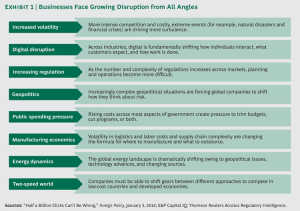Across almost all sectors and regions, companies face unprecedented disruption. The competitive advantages that once gave companies a defensible position—their product lineup, scale, or legacy position—are no longer as secure as they were. Some upstart with a newer and more agile operating model will start taking market share—if it hasn’t already.
In the face of this volatility and complexity, most businesses must transform, meaning a comprehensive change in strategy, operating model, organization, people, and processes. More than ever before, transformation is an imperative. In fact, forward-thinking companies are launching preemptive transformations while they still hold a dominant market position, retooling themselves to stay ahead. The hard reality, however, is that many transformations fail. Some 75 percent fall short of their targets—in terms of value generated, timing, or both.
The Boston Consulting Group, through work with clients in transformation efforts around the world, has developed an approach that flips the odds in a company’s favor. This report is an effort to give transformation leaders the tools and approaches to lead a successful and sustainable transformation effort. (Our transformation approach is illustrated In “Five Case Studies of Transformation Excellence (https://www.bcgperspectives.com/content/articles/transformation_change_management_five_case_studies_transformation_excellence/),” which describes concrete actions taken in transformations across industries and regions.)
Across industries and regions, the need for business transformation is enormous and growing. The competitive environment today is far more unpredictable than it was even a decade ago, with disruption arising from all angles. (See Exhibit 1.)
—-
Embedding Change Management
Depending on complexity, some 50 to 75 percent of change efforts fail. However, a holistic approach to managing change—one that enrolls and activates leaders at all levels, engages the broader organization, and ensures a high level of confidence in initiative delivery—can powerfully flip the odds in favor of success.
To fund the journey and win in the medium term, many high-impact initiatives need to be identified. It is important to establish an initiative roadmap for each, made up of multiple milestones—typically, 15 to 25 are most effective—along with time frames, financial and operational metrics, and clear accountabilities. This roadmap communicates the story of each change initiative in such a way that the transformation team, on the basis of monthly updates, can easily understand what is happening and can make course corrections to ensure ultimate on-time value delivery.
Beyond the quantitative metrics of an initiative, rigor-testing each initiative roadmap can produce tremendous value. This is a qualitative assessment of the robustness and consistency of each plan that ultimately addresses three important areas:
- Is the initiative roadmap clearly defined, logically structured, and readily implementable?
- Is the financial impact at each step clearly identified, along with the source, timing, and leading indicators?
- Are interdependencies and other known risks identified and understood?
Analysis has shown that roadmaps whose rigor test earned “excellent” scores captured an average of 130 percent of their planned value. One company, which had more than 100 initiative roadmaps with 1,800 specific business milestones, performed rigor testing with every initiative team, leveraging the support of its program management office (PMO). By challenging each roadmap with key questions on these three topics, the company had confidence in its ability to deliver on its aggressive goals.
An activist PMO, one that closely supports senior leaders and the transformation agenda, has time and time again proved critical in enabling and facilitating impact across the business—particularly for cross-business initiatives. The value of getting the PMO right cannot be understated. Only one-third of PMO leaders feel that their PMO has realized its full potential to enable change10 within the organization. When leveraged correctly, the PMO helps the leadership team maintain an appropriate pace of change and acts as the steward of the aspiration for change, ensuring that there is a clear line of sight to senior executives regarding implementation progress and any emerging issues. At the same time, it must never usurp the authority of the business units or functions in delivering results. The PMO does not need to be liked, but it should have broad-based respect. “PMO used to be a dirty word around here. This PMO has changed that,” remarked a senior leader at a global oil and gas company whose PMO is now recognized as a key part of a major transformation program.
by Lars Fæste, Jim Hemerling, Perry Keenan, and Martin Reeves
More: BCG
Authors
• Lars Fæste, Senior Partner & Managing Director, Copenhagen
• Jim Hemerling, Senior Partner & Managing Director, San Francisco
• Perry Keenan, Senior Partner & Managing Director, Chicago
• Martin Reeves, Senior Partner & Managing Director, New York

